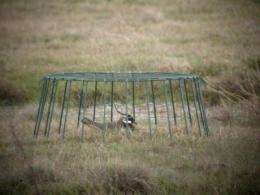Cages and emetics rescue wading birds

The number of waders (shorebirds) in Sweden is falling rapidly. Scientists at the University of Gothenburg have tested drastic new methods to protect species such as the Northern lapwing and redshank from predators, including protective cages over their nests and decoy eggs injected with a drug to induce vomiting.
Populations of shore-breeding wading birds have fallen dramatically in Sweden. One reason is that ground-nesting birds' nests are being robbed by other species. Researcher Daniel Isaksson from the Department of Zoology at the University of Gothenburg has been studying colonies of lapwing and redshank nesting in the coastal meadows of Halland in south-western Sweden for several years.
To reduce nest-robbing, he has tested a number of non-lethal methods to stop the predators. One is to protect the nests by enclosing them in a protective cage, which has had good results.
"Both lapwing and redshank hatched more eggs when their nests were inside the cages," he says. "But this technique works only for species that leave the nest early when a predator is in the vicinity, as species that stay longer risk being trapped and themselves becoming the prey."
Another method tested was to put out artificial nests containing ordinary hens' eggs painted to resemble waders' eggs and injected with an emetic - a drug that induces vomiting. The idea was to "teach" the predators that waders' eggs are inedible.
"We found that predation of the real waders' eggs immediately decreased during the first three weeks in areas with the decoy eggs, which suggests that the method had an effect."
Isaksson's studies also show that nest-robbing and the positioning of waders' nests are to a great extent governed by the surrounding environment.
"For example, crows like elevated perches such as fences where they can keep watch and avoid attacks by lapwings," he says. "In two out of three years, the lapwings therefore positioned their nests further and further away from such sites. This limits the lapwing's breeding area and probably impacts on the size of the local population."
Provided by University of Gothenburg















